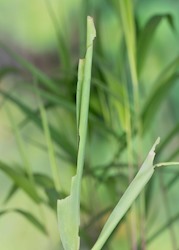Common Roadside-Skipper Amblyscirtes vialis
Butterfly: Wingspan: 1 - 1½ inches (2.86 - 3.5 cm) UPPER SURFACE (dorsal) Dark brown. Pale "wrist bracelet." UNDER SURFACE (ventral) Dark brown with extensive lavender frosting. Prominent tooth-like dot row near forewing tip. Fringes black and tan checkered. Abdomen ringed with white at segment joints.
Egg: Dome shaped. Whitish; unmarked.
Caterpillar: Pale green, covered with heavy white frosting. Numerous tiny tubercles. Head pinkish brown covered with white frosting; midline brown facial stripe bordered by two vertical dashes. Collar black. First three pairs of legs (thoracic) pale. Mature caterpillars overwinter..
Chrysalis: Green with reddish hue at both ends of body. Proboscis case red beyond wing cases.












_Charny.jpg)
_Charny.jpg)








.jpg)
.jpg)

















